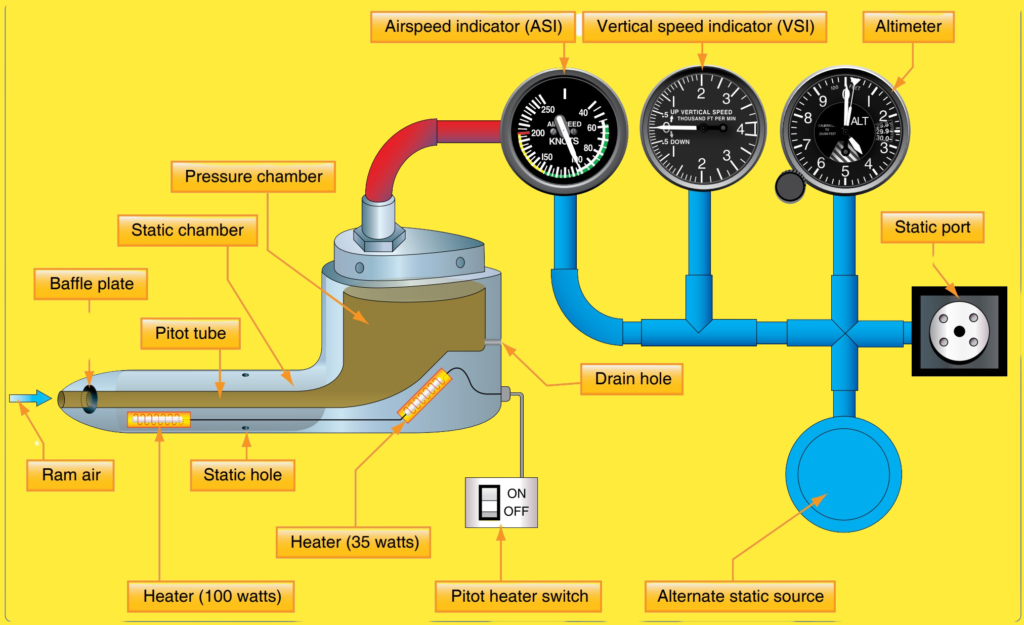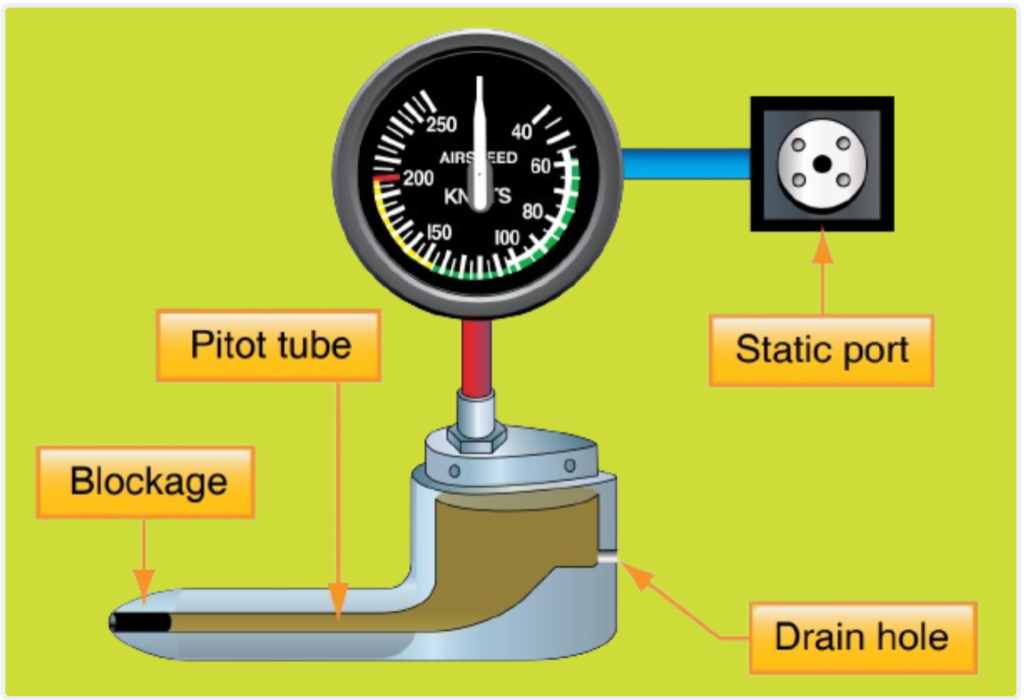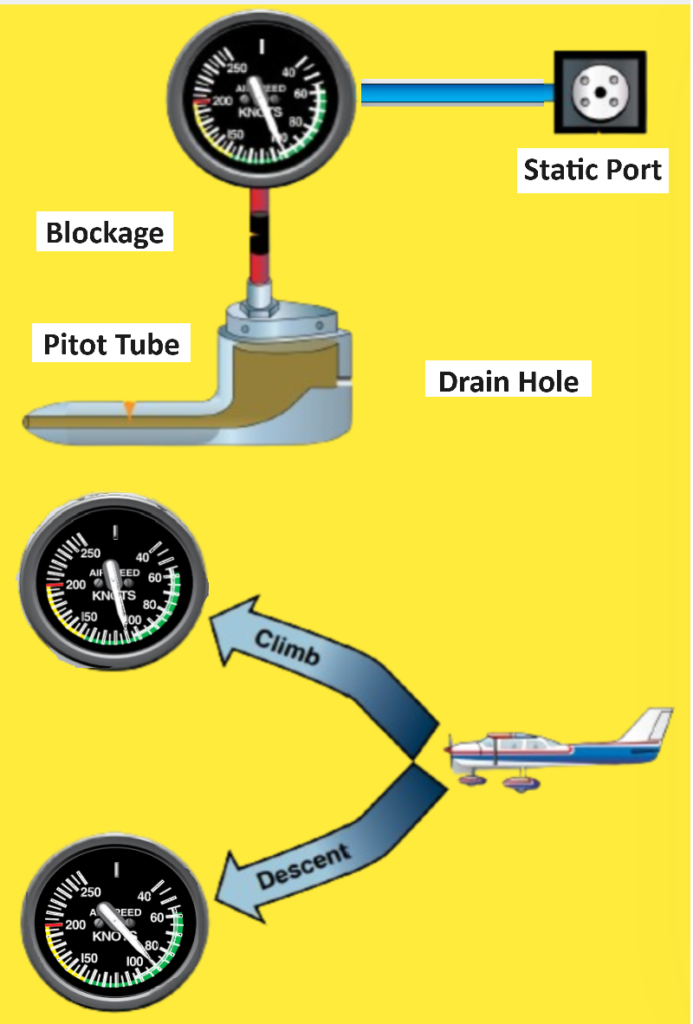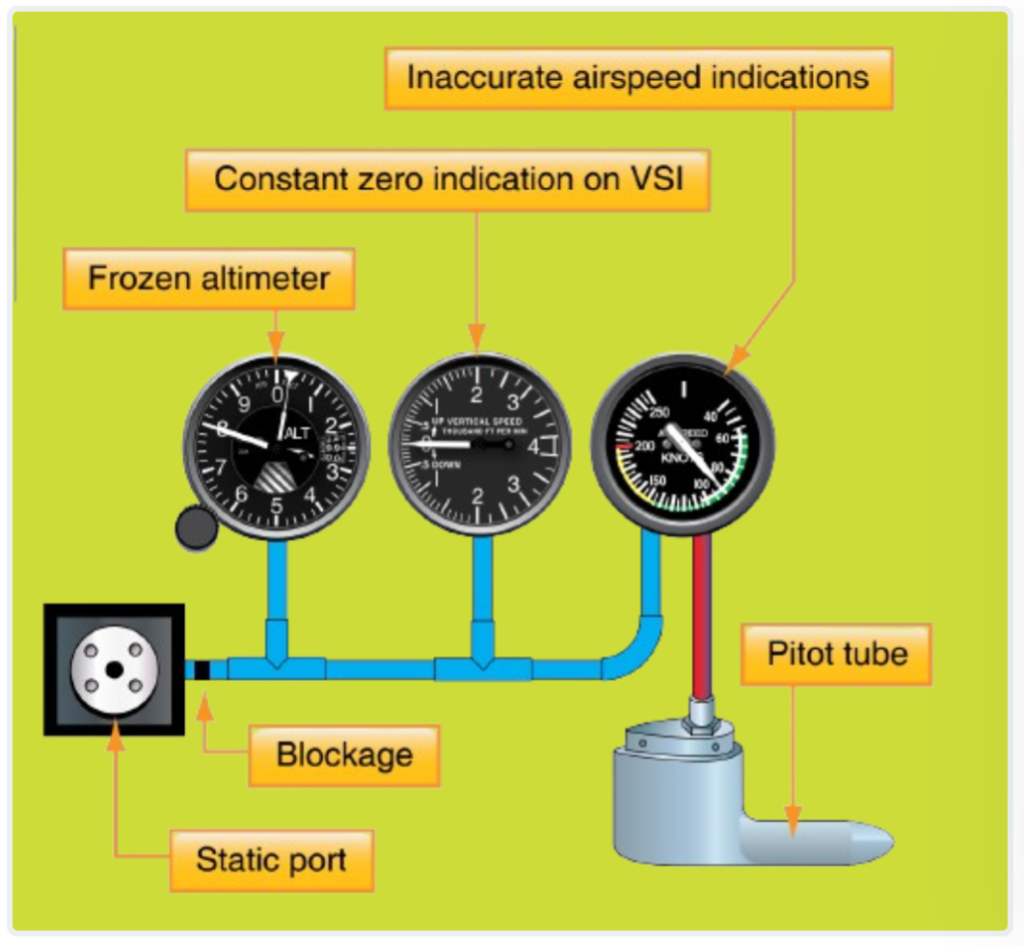The pitot static system is a combined system that relies on both static air pressure and dynamic pressure generated by the aircraft’s motion through the air. These pressures work together to power essential flight instruments, including the airspeed indicator (ASI), altimeter, and vertical speed indicator (VSI).
What is Pitot Static System?
A pitot static system is a set of instruments used in aviation to measure an aircraft’s airspeed, altitude, and altitude trend. It includes a pitot tube, which senses the air pressure caused by the aircraft’s motion, and a static port, which measures the surrounding air pressure. These instruments provide crucial information for pilots to safely operate the aircraft.
In addition to the pitot tube and static port, the system may also include other instruments like airspeed indicator (ASI), altimeter, and vertical speed indicator (VSI). These instruments help gather and process data for various purposes, such as controlling cabin pressurization and monitoring airspeed switches.
It’s important for these instruments to provide accurate readings because errors in the pitot static system can lead to dangerous situations. For example, incorrect altitude readings could result in the aircraft flying at the wrong height, potentially leading to accidents. Several airline disasters have been linked to failures in the pitot static system, highlighting the critical importance of maintaining its accuracy and reliability.

Impact Pressure Chamber and Lines.
The pitot tube serves to measure the total pressures experienced when an aircraft is in motion through the air. Static pressure, also known as ambient pressure, remains constant whether the aircraft is in motion or stationary, representing the local barometric pressure.
In contrast, dynamic pressure arises only when the aircraft is in motion, making it a product of the aircraft’s movement through the air. Wind also generates dynamic pressure, regardless of whether the aircraft is moving or not. Interestingly, the speed of the wind does not affect dynamic pressure; thus, an aircraft moving through still air at a certain speed generates the same dynamic pressure as when facing a wind of equal speed.
When wind direction is less than 90° off the nose of the aircraft, dynamic pressure affects the airspeed indicator (ASI). This means that wind blowing across the airfoil, even at a certain speed, produces the same dynamic pressure as the aircraft moving through calm air at the same speed.
The pitot tube plays a crucial role in capturing both dynamic pressure and the constant static pressure. This information is essential for various flight instruments to accurately determine airspeed and other critical flight parameters.
The pitot tube features a small opening at its front, allowing total pressure, comprised of both dynamic and static pressure, to enter the pressure chamber. Additionally, a small hole at the back of the chamber facilitates moisture drainage, ensuring proper function in the event of precipitation. It’s crucial to check both openings before flight to prevent blockages. Many aircraft are equipped with pitot tube covers during periods of inactivity to prevent debris accumulation.
Among the flight instruments, the airspeed indicator (ASI) exclusively utilizes the pitot tube. Total pressure from the pitot tube’s chamber is transmitted to the ASI via a small tube. Simultaneously, static pressure is delivered to the opposite side of the ASI, effectively canceling out the two static pressures and leaving only dynamic pressure to be indicated on the instrument. As dynamic pressure fluctuates, the ASI reflects corresponding increases or decreases in airspeed.
Conversely, the altimeter and vertical speed indicator (VSI) solely rely on static pressure derived from the static port for their readings. This setup ensures accurate measurement across various flight conditions, enhancing overall flight safety.
Static Pressure Chamber and Lines.
The static pressure chamber in an aircraft is designed to vent to the free, undisturbed air on the side(s) of the aircraft. This allows atmospheric pressure changes to freely affect the pressure inside the chamber. Small lines connect the instruments to the static system, enabling the movement of pressure in and out of the instruments as needed.
Some aircraft are equipped with an alternate static source, typically located inside the flight deck. This serves as a backup in case the primary static source becomes blocked or compromised. The alternate static source takes advantage of the venturi effect created by airflow around the fuselage. This effect causes the air pressure inside the flight deck to be lower than the exterior pressure, ensuring a reliable source of static pressure for the instruments even in emergency situations.
When the alternate static source pressure is utilized, pilots observe specific instrument indications:
- The altimeter indicates a slightly higher altitude than the actual altitude.
- The airspeed indicator (ASI) displays an airspeed greater than the actual airspeed.
- The vertical speed indicator (VSI) initially shows a momentary climb and then stabilizes if the altitude is maintained constant.
To ascertain the extent of error introduced into the system when using the alternate static source, pilots should refer to the Aircraft Flight Manual (AFM) or the Pilot’s Operating Handbook (POH).
In aircraft lacking an alternate static source, an alternative method involves breaking the glass face of the VSI to introduce static pressure into the system in the event of a blockage. However, this action renders the VSI inoperative. The VSI is chosen for this purpose due to its relatively lesser importance compared to other static source instruments for flight.
Blockage of the Pitot Static System.
Errors in flight instruments typically indicate blockages in the pitot tube, static port(s), or both. Blockages can result from moisture, such as ice or dirt, and even insects. During preflight checks, it’s essential to ensure the removal of the pitot tube cover and then inspect both the pitot and static port openings.
A blocked pitot tube affects the accuracy of the airspeed indicator (ASI). However, a blockage in the static port not only impacts the ASI but also leads to errors in the altimeter and vertical speed indicator (VSI). Therefore, maintaining clear and unobstructed pitot and static port openings is crucial for accurate instrument readings and safe flight operations.
1. Blocked Pitot System.
When the pitot system becomes blocked, whether completely or partially, it can lead to significant issues. If the pitot tube itself is blocked while the drain hole remains open, ram air is unable to enter the pitot system. Consequently, the air already present in the system escapes through the drain hole, causing the remaining pressure to drop to ambient air pressure. In such a scenario, the airspeed indicator (ASI) reading decreases to zero because no difference exists between ram and static air pressure. With dynamic pressure unable to enter the pitot tube, the ASI ceases to function. However, since the pitot drain hole remains open, static pressure can equalize on both sides.

The apparent loss of airspeed is usually not instantaneous but occurs very rapidly. If both the pitot tube opening and the drain hole become clogged simultaneously, the pressure in the pitot tube becomes trapped. In this situation, no change is observed in the airspeed indication even if the airspeed increases or decreases. However, if the static port remains unblocked and the aircraft changes altitude, a change is noted on the ASI due to the alteration in static pressure, not airspeed. While the total pressure in the pitot tube remains constant despite the blockage, changes in static pressure occur.
For instance, consider an aircraft brought to a standstill at a given altitude. Assuming both the static port (providing static pressure) and the pitot tube (providing dynamic pressure) are unobstructed, several conclusions can be drawn:

- The airspeed indicator (ASI) would display zero.
- Dynamic pressure and static pressure would be equal.
- As dynamic pressure encompasses both static pressure and dynamic pressure itself, the sum of these two pressures remains constant at zero speed.
It follows that the airspeed indication must be derived from a relationship between these two pressures, which indeed it is. The ASI utilizes static pressure as a reference pressure, maintaining the ASI’s case at this pressure behind the diaphragm. Meanwhile, dynamic pressure from the pitot tube is connected to a sensitive diaphragm within the ASI’s case. Since an aircraft at rest (regardless of altitude) implies zero airspeed, the pitot tube consistently provides static pressure alongside dynamic pressure. Consequently, airspeed indication arises from the comparison of two pressures: the static and dynamic pressure from the pitot tube against the static pressure in the ASI’s case.
If the aircraft descends while the pitot tube is obstructed, the pressure in the pitot system, including the diaphragm, remains constant. However, as the descent progresses, the increasing static pressure acts against the diaphragm, causing it to compress and indicating decreased airspeed. Conversely, during a climb, decreasing static pressure allows the diaphragm to expand, showing an indication of higher airspeed.
Moisture during flight can lead to blockage of the pitot tube. Some aircraft may be equipped with pitot heat to address moisture-related issues. Pilots should refer to the Aircraft Flight Manual (AFM) or Pilot’s Operating Handbook (POH) for specific procedures regarding the use of pitot heat.
2. Blocked Static System.
If the static system becomes blocked while the pitot tube remains clear, the airspeed indicator (ASI) continues to function, albeit inaccurately. At altitudes above where the static ports became blocked, the ASI displays a lower airspeed than the actual value because the trapped static pressure is higher than normal for that altitude. Conversely, at lower altitudes, the ASI indicates a faster airspeed than actual due to the relatively low static pressure trapped in the system.
Applying similar principles as with a blocked pitot tube, the behavior of a blocked static port is analogous. If the aircraft descends, the increase in static pressure on the pitot side leads to an apparent increase in airspeed on the ASI, assuming the aircraft’s actual speed remains constant. This increase in static pressure effectively mimics an increase in dynamic pressure since the static side’s pressure remains unchanged.
Conversely, if the aircraft begins to climb after a static port becomes blocked, the ASI displays a decreasing airspeed as the climb continues. This decrease occurs due to the declining static pressure on the pitot side, while the static pressure on the static side remains constant.

A blockage in the static system also affects the altimeter and vertical speed indicator (VSI). Trapped static pressure freezes the altimeter at the altitude where the blockage occurred. Similarly, a blocked static system causes the VSI to indicate a continuous zero rate of climb or descent.
Some aircraft feature an alternate static source in the flight deck. When a blocked static source is detected, opening the alternate static source introduces static pressure from the flight deck into the system. Flight deck static pressure is lower than outside static pressure, so pilots should consult the aircraft’s Aircraft Operating Manual (AOM) or Pilot’s Operating Handbook (POH) for airspeed corrections when utilizing the alternate static pressure.